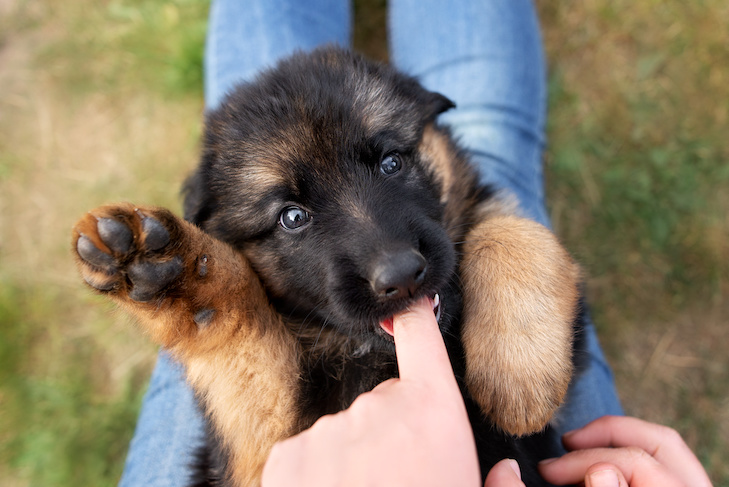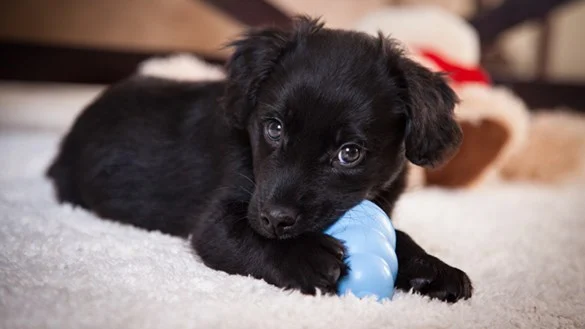Puppy biting and mouthiness are some of the most common concerns raised by new dog owners — and unfortunately, they’re also among the behaviours where we see some of the worst advice shared online.
There’s a reason non-professionals aren’t allowed to offer medical or legal advice to strangers on the internet: their guidance might be misguided at best — and dangerous at worst. The same principle should apply to dog training.
Especially with puppies, whose brains are in a delicate and rapidly developing phase (including at least two fear periods in their first year), it’s essential that the information you rely on is scientifically grounded and professionally recommended.
The good news? In the vast majority of cases, puppy biting is entirely normal. Here’s why:
1. Why Do Puppies Bite?
Mouth exploration: Puppies use their mouths much like human babies use their hands — to learn about the world around them.
Teething: Between 3 and 6 months, puppies go through an uncomfortable teething phase that can make them gnaw on everything.
Play habits: Puppies learn bite inhibition from their siblings. Mouthing is a natural way to initiate play and interact.
Breed tendencies: Retrievers are inclined to carry things — including arms, sleeves, and hands. Herding breeds (like Collies, Heelers) are genetically wired to nip, chase, and control movement — often aimed at fast-moving kids.


2. What Not to Do About Puppy Biting
It’s vital to address this behaviour with calm, consistent, non-physical strategies. Unfortunately, many owners are still given outdated or harmful advice like:
- Squeezing the puppy’s mouth shut
- Alpha-rolling (pinning the puppy on its back)
- Muzzling as punishment
These methods aren’t just ineffective — they’re potentially harmful. Research has long debunked dominance theory as a basis for training. There’s no need to establish yourself as the “alpha.” Physical punishment often leads to fear, reduced trust, and even aggression.
3. What To Do About Puppy Biting
As with all behaviour, prevention and redirection start by meeting your puppy’s needs. A tired, hungry, or under-stimulated puppy is far more likely to bite. So before tackling training, ask:
- Is your puppy getting enough sleep during the day?
- Are they being offered three meals a day?
- Do they have appropriate toys and outlets for chewing?
- Are they getting enough age-appropriate play, enrichment, and exercise?
Once their needs are met, here’s a framework you can follow:
Teaching Your Puppy Not to Bite
1. Respond immediately – and calmly.
If your puppy puts teeth on your skin, there is no need for yelling, yelping or pushing away. Try to redirect immediately to what your Puppy can bite and chew on and make that much more exciting than your fingers, hands or shoe laces. If needed, step behind a baby gate or quietly leave the room for a few seconds.
2. No need for ‘punishment’ time-outs — just pause the interaction.
Time-outs often involve too much handling or attention. Instead, quietly step away to clearly signal that biting ends the fun.
3. Consistency is key.
The whole household must follow the same protocol. If one person laughs, another scolds, and someone else plays through it, your puppy won’t learn your house rules.
4. Praise the good!
Catch and reward calm, soft-mouth interactions. Reinforce the behaviours you want to see more of.
5. Consider breed-specific outlets.
A herding puppy might need a flirt pole, while a retriever may thrive with frequent fetch games. Channel their instincts appropriately rather than suppressing them.
Why This Works
- Behaviours that aren’t reinforced fade away.
- Puppies learn that biting ends interaction, not begins it.
- Calm withdrawal teaches self-regulation.
- Over time, your puppy will try more appropriate strategies (like sitting or lying down) to get your attention.
Extra Tips for Success
- Give your puppy daily downtime in a puppy-safe area (playpen or gated space) where they can decompress.
- Make sure they have rubbery, satisfying teething toys available.
- Make sure your Puppy is getting enough sleep. Overtired puppies bite more.
- Don’t mistake excitement for aggression. High-energy biting usually looks chaotic, not calculating.
When to Seek Professional Help
Most puppy biting improves steadily with the right approach. But you should consult a qualified professional if your puppy:
- Growls, snaps, or stiffens when someone approaches food or toys
- Freezes, stares, and then bites without engaging in play
- Bites consistently and breaks skin
- Shows fear-based aggression (e.g. barking or lunging at new people)
- Reacts negatively to gentle petting or handling
Puppy biting can feel frustrating, but it’s a completely normal developmental stage. With calm consistency and kind redirection, most puppies grow out of it by 5–6 months of age.
If you’re dealing with a particularly mouthy pup or biting that seems intense or persistent beyond that age, don’t wait. Seek support from a certified professional trainer who understands modern, science-backed methods.
The APDT Ireland is here to help – and we’re proud to offer a directory of qualified, kind, and competent trainers across the country.
